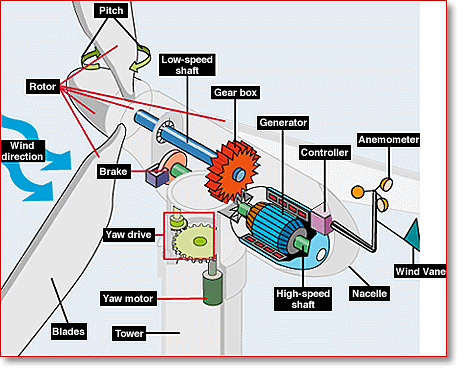
Courtesy of: http://www.suntam.com/english/d/file/Technology/Research/2009-01-07/8aa6b81f31ca0bd.jpg
GeneratorsAn explanation of generators is necessary to understand how the next two types of alternative energies, wind and hydroelectric, actually produce their power. The electric generator was actually a concept discovered and documented by the well known physicist Michael Faraday in 1831 (2). A generator is in fact nothing more than conductive wire inside of a magnet, which when the conductive wires spin, an induced current is created in the wires (4). Also, the number of loops that the wire makes determines how much current is created, as the current is scaled by the number of coils there are inside this magnetic field (2). This means that any force that can spin these wires can convert the mechanical energy used into electrical energy which can be stored or used. Another interesting fact is that generators are actually electric motors run in reverse, and as we've seen in class, having a generator run on one end, can power the electric motor on the other end. This is an important concept to understand and for more information you can watch the included video of Steve Jones explaining electric generators to the left. |

Courtesy of: http://www.suntam.com/english/d/file/Technology/Research/2009-01-07/8aa6b81f31ca0bd.jpg
Using Wind Turbines for Generating PowerAs discussed before, wind is a powerful natural occurrance, that if we could fully tap into, we could power many of our facilities and homes via wind power. This is where wind turbines actually come in, as they allow us to convert this mechanical energy that blows by us everyday and turn it into electrical power, which can be used to run many of our modern appliances. The idea is that you have a large wind turbine which has a number of blades that work much like an airplane wing. As the wind passes through the blades, lift is produced by this interaction and actually cause the fan blades to rotate about their free axis (6). As you should know now, this movement is all that is needed to create current in a generator which is precisely how they harness the power of the wind. An important side note is that while the wind is moving quickly at times, the fan blades move relatively slowly, and without some way of mechanically increasing the internal speed, the conductive coil of wires would not spin very quickly inside of the generator. The gearbox which is mounted before the mechanical movement reaches the generator, helps to increase this speed of rotation, thus producing a steady current (6). Steve Jones has graciously agreed to explain wind power to those that wish to know more of the physics behind these turbines.There are two common forms of wind turbine: horizontal axis wind turbines (HAWT) or vertical axis wind turbines (VAWT). HAWTs are more common to find than VAWTs as they have the distinct advantage of turning towards the wind and having their fan blades perpendicular to the movement of air. However, they are not without issues, as the gearbox and generator are mounted up with the fanblades and put higher stress on the stand which raises these components in the air. VAWTs are a different design than HAWTs as VAWTs spin about the Y-axis or the axis which the HAWTs actually use to hold the gearbox and generator. They have the advantage of being easier to maintain because their gearbox and generator are located on the ground, but are more susceptible to high winds damaging the system, meaning that they are both easier to maintain, and need to be maintained more often. Also, if the wind is blowing at just the right angle, these blades will need to have some other form of energy to help them start to move (6). |